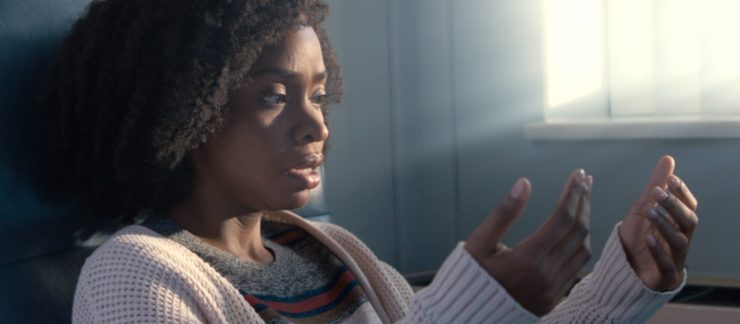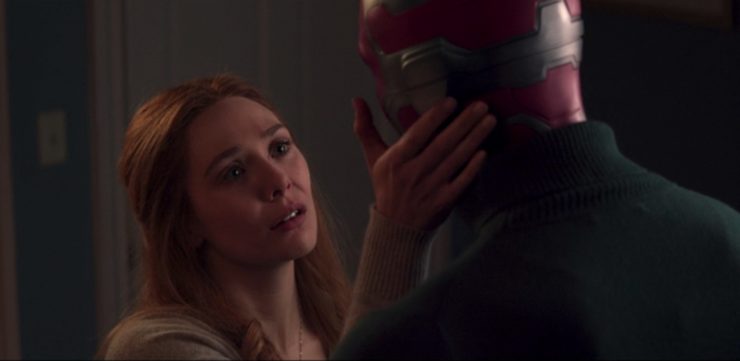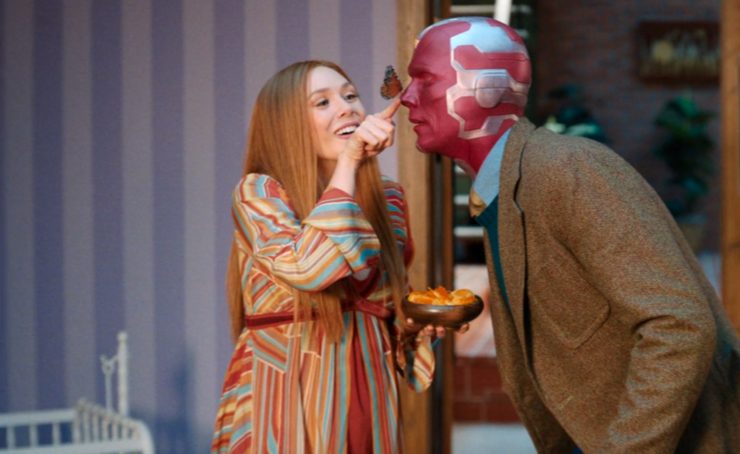One of the benefits of doing a serial narrative—not serialized, necessarily, but simply any narrative where a new installment comes out on a regular basis, whether it’s a weekly TV show, a monthly comic book, or a daily comic strip—is that you have the option of showing development and growth and detailing the consequences of actions.
One of the benefits of Marvel Studios releasing TV shows on Disney+ that tie aggressively into the movies is that they can finally explore significant repercussions and character growth to a degree they really can’t in the cinematic center of the milieu, as we have seen done superbly in WandaVision.
SPOILERS FOR ALL NINE EPISODES OF WANDAVISION, AND SEVERAL OTHER MARVEL CINEMATIC UNIVERSE PRODUCTIONS AS WELL
A big reason why we’ve had such a massive renaissance in superhero movies since the turn of the millennium is because Bryan Singer & Co. with the first two X-Men films and Sam Raimi & Co. with the Tobey Maguire Spider-Man movies did something very few other superhero adaptations had done before: they thoroughly embraced the source material. Far too many 20th-century superhero movies made as little use of the rich and lengthy history of these characters in the comics as possible. Supporting casts and regular villains were avoided, backstories changed. (It’s perhaps not a coincidence that the most successful were the Adam West Batman, the Christopher Reeve Superman, and Keaton/Kilmer/Clooney Batman adaptations, all of which arguably kept the most stuff from the original four-color versions.)
Buy the Book


Defekt
Kevin Feige and his various writers and directors at Marvel Studios have taken that to the next level, integrating decades of comics history into their narratives—reinterpreting them for the 21st century, but never losing sight of the many storytelling possibilities that they were given in four-color form.
The thing is, those storylines were played out on a monthly basis over decades, with room to grow and breathe and flesh the characters out. Marvel in particular, as initially guided in the 1960s by Stan Lee and his bullpen of artists and fellow scripters, embraced the notion of growth and change. Peter Parker eventually graduated high school and went to college, and later grad school. Reed Richards and Sue Storm got married and had a kid. Tony Stark and Carol Danvers both dealt with alcoholism. Vision and the Scarlet Witch fell in love, got married, then got nastily separated. The Hulk started out gray, then got green, then back to gray, then green again, then red; he got more primitive and then smarter and then even more primitive and back around again. Magneto went from villain to tragic figure to attempted hero and back to villain again. Hawkeye, the Black Widow, Quicksilver, Emma Frost, Mystique, and Songbird were all introduced as villains, and later became heroes. And so on.
That’s easy to do when you’ve got at least one, and often several, stories per month featuring these characters. It’s a lot harder to pull off when you’re only doing 1-3 movies per year.
Movies—especially those of the tentpole blockbuster variety that have been the mainstream of Hollywood since Jaws and Star Wars four-and-a-half decades ago—don’t generally have the storytelling space to develop things too far. Plots need to be completed in the 2-3 hours the movies have, and that’s pretty much it. You can’t focus too much energy on larger storylines because they won’t pick up for a year or more. One of the most amazing things Feige et al. have accomplished is striking a balance between creating movies that are compelling on their own but are still part of a larger narrative. So many other attempts to do “cinematic universes” (DC’s ongoing train wreck, Tom Cruise’s Mummy, the Andrew Garfield Spider-films) have crashed and burned due to an inability to thread that needle.
But one way to achieve the necessary balance is to only scratch the surface of consequences of major shifts and events. The only impact that the Sokovia Accords that were passed in Captain America: Civil War had was to give authorities a reason to ignore due process while hunting down Bucky Barnes in that movie, to give a reason for Scott Lang to be under house arrest in Ant-Man & The Wasp, and…that’s pretty much it. (They were paid lip service in Avengers: Infinity War, but the events of that movie made the Accords irrelevant.)
The Sokovia Accords should be a massive deal, having a broad-ranging impact on the Marvel Universe. And we did eventually get to see that impact—in the TV show Agents of S.H.I.E.L.D. For that matter, the Battle of New York that made up the climax of Avengers is another huge event that should have all manner of consequences, but beyond being something of a plot catalyst in Spider-Man: Homecoming, we didn’t see that much of the aftermath—except in the first season of Netflix’s Daredevil, which dealt with the impact that battle had on the neighborhoods of central Manhattan.
Those two small-screen examples have given Marvel Studios a good blueprint, and WandaVision has proven to be following it superbly by addressing two key bits of story from the movies that were inadequately dealt with on the big screen.

One is the impact of Thanos’ snap in Infinity War, and, more to the point, the impact of the Hulk’s counter-snap in Avengers: Endgame. The latter in particular was pretty much an abstraction in Endgame and played for laughs in Spider-Man: Far from Home. WandaVision has done a much better job of showing the terrible toll it has taken, both on those left behind and those who were reconstituted. Monica Rambeau was dusted at a time when her mother’s cancer was in remission, and one subjective second later was told that the cancer came back and killed her. With Rambeau mère dead and Rambeau fille dusted, SWORD winds up in the incapable hands of the Peter Principle That Walks Like a Man, Tyler Hayward.
Meanwhile, Wanda Maximoff had just watched Thanos kill Vision in front of her face, and then came back to find that, not only had his body had been taken by SWORD, but Hayward won’t let her have his body for burial. Oh, and Wanda finds out that Vision also bought them a house. (It’s not clear whether the house was torn down in the intervening five years or if construction had started on the house and was abandoned during the blip years.)
Which leads me nicely to the other bit of story, which is Wanda and Vision in general. Because if big-ass action blockbusters have difficulty dealing with long-term consequences, they also have an issue of developing characters beyond a relatively small handful of people. Which is fine if you’re doing a Captain America movie or a Black Panther movie or a Captain Marvel movie. It’s more of a challenge when you’re doing an Avengers movie, and it’s telling that even the first movie, which was most successful at balancing the characters, is remembered at least in part as the one where Hawkeye had virtually nothing to do.
Prior to the Disney+ TV show, Wanda and the Vision were barely even characters. Wanda’s primary function in Avengers: Age of Ultron was to catalyze the plot, giving Tony Stark apocalyptic hallucinations that indirectly led to his creation of the movie’s titular villain. She had the exact same role in Civil War, her actions in Lagos (which were actually heroic; had she not sent the bomb into the air, the damage would’ve been far worse, but all most people saw was the damage done) leading to the UN session that passes the Sokovia Accords. Vision’s primary function in Age of Ultron was to function as a deus ex machina in becoming the one to stop Ultron, and his function in Civil War was to provide pathos when he and Wanda wind up on differing sides.
The movies themselves did very little work to show us their growing relationship, and what work was done was entirely on the backs of the actors. Elizabeth Olsen and Paul Bettany completely sold it—particularly in their furtive, clandestine meeting in Scotland in Infinity War, which filled in a lot of blanks. But those blanks were very much present, as the scripts for Age of Ultron and Civil War were relying far too much on the characters’ four-color history as a couple to fill in the gaps that the movies just didn’t have time to deal with.

WandaVision mercifully changed that, and retroactively makes the movies resonate far more in the process. Starting with the goofiness of the early episodes showing the pair of them bantering and navigating artificial sitcom conflicts, then eventually in “Previously On” showing, in more depth, how the relationship developed. We finally get to see what went on between the lines that we were forced to infer amidst the hugger-mugger of the big-ass action movie.
The Marvel Cinematic Universe has done very little to depict the everyday lives of superheroes. The dictates of the Hollywood blockbuster are such that character beats are, at best, there to set up or provide a pause between action sequences. The MCU films are better about this than most, and it’s to their credit that they do as much as they do on this front. They’ve managed to make Tony Stark, Steve Rogers, Carol Danvers, T’Challa, Natasha Romanoff, Peter Parker, Thor, Scott Lang, and Bruce Banner into complex characters even within the constraints of the format.
But so many others have been left underdeveloped. Two of those have now been magnificently addressed by WandaVision (and two more will be addressed in a couple of weeks in Falcon and the Winter Soldier). As an added bonus, this has all been accomplished in the form of a truly superlative TV show that has beautifully explored issues of grief and questions of how power can corrupt, as well as fleshing out the world of magic in the MCU. All that, and WandaVision gives us forward motion as well, with two more movies set up in the end of the first season—both Captain Marvel 2 with a Skrull talking to Rambeau and Doctor Strange and the Multiverse of Madness, which is Elizabeth Olsen’s next appearance.
Keith R.A. DeCandido also wrote about how WandaVision mined decades of comics history for its storyline. His “4-Color to 35-Millimeter: The Great Superhero Movie Rewatch” has covered every live-action movie based on a superhero comic, and he’ll be reviewing each episode of Falcon & The Winter Soldier as it comes out. He’s been writing about Star Trek, old and new, for this site since 2011, among many other subjects. Outside of Tor.com, he’s the author of nearly 60 novels (most recently Animal, a thriller written with Dr. Munish K. Batra), more than 75 short stories (the latest of which is in the charity anthology Turning the Tied, out this weekend), and around 50 comic books (the latest of which is Icarus, adapting Gregory A. Wilson’s science fiction novel).










